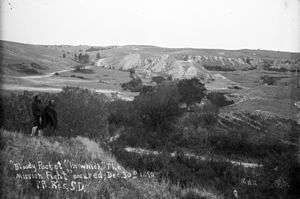Drexel Mission Fight
| Drexel Mission Fight | |||||||
|---|---|---|---|---|---|---|---|
| Part of the Ghost Dance War, Sioux Wars | |||||||
 The 'Bloody Pocket'; location of the Drexel Mission Fight | |||||||
| |||||||
| Belligerents | |||||||
|
|
Lakota Sioux Brulé Sioux | ||||||
| Commanders and leaders | |||||||
|
| Chief Two Strike | ||||||
| Strength | |||||||
|
7th U.S. Cavalry 9th U.S. Cavalry | |||||||
The Drexel Mission Fight was an armed confrontation between Lakota warriors and the United States Army that took place on the Pine Ridge Indian Reservation in South Dakota on December 30, 1890, the day after the Wounded Knee Massacre. The fight occurred on White Clay Creek approximately 15 miles north of Pine Ridge where Lakota were purported to have burned the Catholic Mission.
Seventh Cavalry under the command of Col. James W. Forsyth with eight troops and a platoon of artillery, the same elements engaged at Wounded Knee the previous day, became engaged by Brulé Lakota from the Rosebud Indian Reservation after reconnoitering to determine if the Catholic mission had been torched. These Indians were purported to be the same Brulé Lakota under Chief Two Strike that had attacked the 9th Cavalry's supply train earlier that morning. The Seventh Cavalry was hotly engaged in a valley by the combined Lakota forces while trying to break contact and withdraw.[1] A battalion of the Ninth Cavalry, a Buffalo Soldier regiment under the command of Maj. Guy V. Henry and nicknamed the Henry's Brunettes, responded to Forsyth's request for assistance, and the combined cavalry forces drove the Lakota from commanding positions on the heights.[2]
In an investigation of the Drexel Mission fight, Maj. Gen. Nelson A. Miles, the commanding general of the Pine Ridge Campaign, severely criticized Forsyth for allowing his command to be pinned down in a valley. He submitted his findings as a supplement to his investigation of Forsyth's conduct at Wounded Knee. Secretary of War Redfield Proctor set aside the Drexel Mission investigation after exonerating Forsyth of any wrongdoing at Wounded Knee.[1]
Three soldiers were awarded the Medal of Honor for actions at White Clay Creek including to Captain Charles A. Varnum, First Sergeant Theodore Ragnar, and Farrier Richard J. Nolan. Almost three decades later Second Lieutenant Sedgwick Rice was awarded a Distinguished Service Medal.[1]
See also
Notes
- 1 2 3 Robert M. Utley: The Last Days of the Sioux Nation. Yale University Press, New Haven, CT (1963), pages 231- 250, ISBN 0-300-10316-6.
- ↑ Jeffrey Ostler: The Plains Sioux and U.S. colonialism from Lewis and Clark to Wounded Knee pgs. 357-358, Cambridge University Press (2004) ISBN 0-521-60590-3